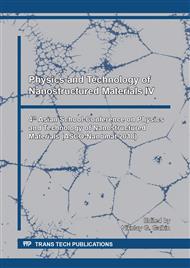[1]
G. Neuber, et al., Temperature-dependent spectral generalized magneto-optical ellipsometry, Appl. Phys. Lett. 83 (2003) 4509.
DOI: 10.1063/1.1629145
Google Scholar
[2]
H. Fujiwara, Spectroscopic ellipsometry principles and applications, John Wiley & Sons, Chichester, (2007).
Google Scholar
[3]
Q.J. Nederpel, J.W.D. Martens, Magneto‐optical ellipsometer, Rev. Sci. Instrum. 56 (1985) 687.
Google Scholar
[4]
A. Berger, M.R. Pufall, Generalized magneto-optical ellipsometry, Appl. Phys. Lett. 71 (1997) 965.
DOI: 10.1063/1.119669
Google Scholar
[5]
K. Mok et al., Vector-magneto-optical generalized ellipsometry, Rev. Sci. Instrum. 82 (2011) 33112.
Google Scholar
[6]
K. Mok et al., Thickness independent magneto-optical coupling constant of nickel films in the visible spectral range, J. Appl. Phys. 110 (2011) 123110.
DOI: 10.1063/1.3672834
Google Scholar
[7]
K. Mok et al., Magneto-optical coupling in ferromagnetic thin films investigated by vector-magneto-optical generalized ellipsometry, Phys. Rev. 84 (2011) 094413.
DOI: 10.1103/physrevb.84.094413
Google Scholar
[8]
O.A. Maximova, et al., In situ magneto-optical ellipsometry data analysis for films growth control, JMMM 440 (2017) 196–198.
Google Scholar
[9]
O.A. Maximova, et al., Single-layer model of reflective nanostructures for magneto-ellipsometry data analysis, IOP Conference Series: Materials Science and Engineering 155 N. 1 (2016) 012030.
DOI: 10.1088/1757-899x/155/1/012030
Google Scholar
[10]
O.A. Maximova, et al., Two-layer model of reflective ferromagnetic films in terms of magneto-optical ellipsometry studies, SibFU Journal. Mathematics & Physics 10 N.2 (2017) 223–232.
Google Scholar
[11]
O.A. Maximova, et al., Features of the ellipsometric investigation of magnetic nanostructures, J. Struct. Chem. 55 (6) (2014) 1134–1141.
Google Scholar
[12]
R.M.A. Azzam, N.M. Bashara, Ellipsometry and polarized light, North-Holland Pub. Co, Amsterdam, (1977).
Google Scholar
[13]
I.A. Tarasov, et al., Quick ellipsometric technique for determining the thicknesses and optical constant profiles of Fe/SiO2/Si(100) nanostructures during growth, Tech. Phys. 57 (2012) 1225.
DOI: 10.1134/s1063784212090241
Google Scholar
[14]
Information on https://www.mathworks.com/products/matlab.html matlab.
Google Scholar
[15]
J.A. Nelder, A.D. Mead, A simplex method for function minimization, Comput. J. 7 (1965) 308–313.
Google Scholar


